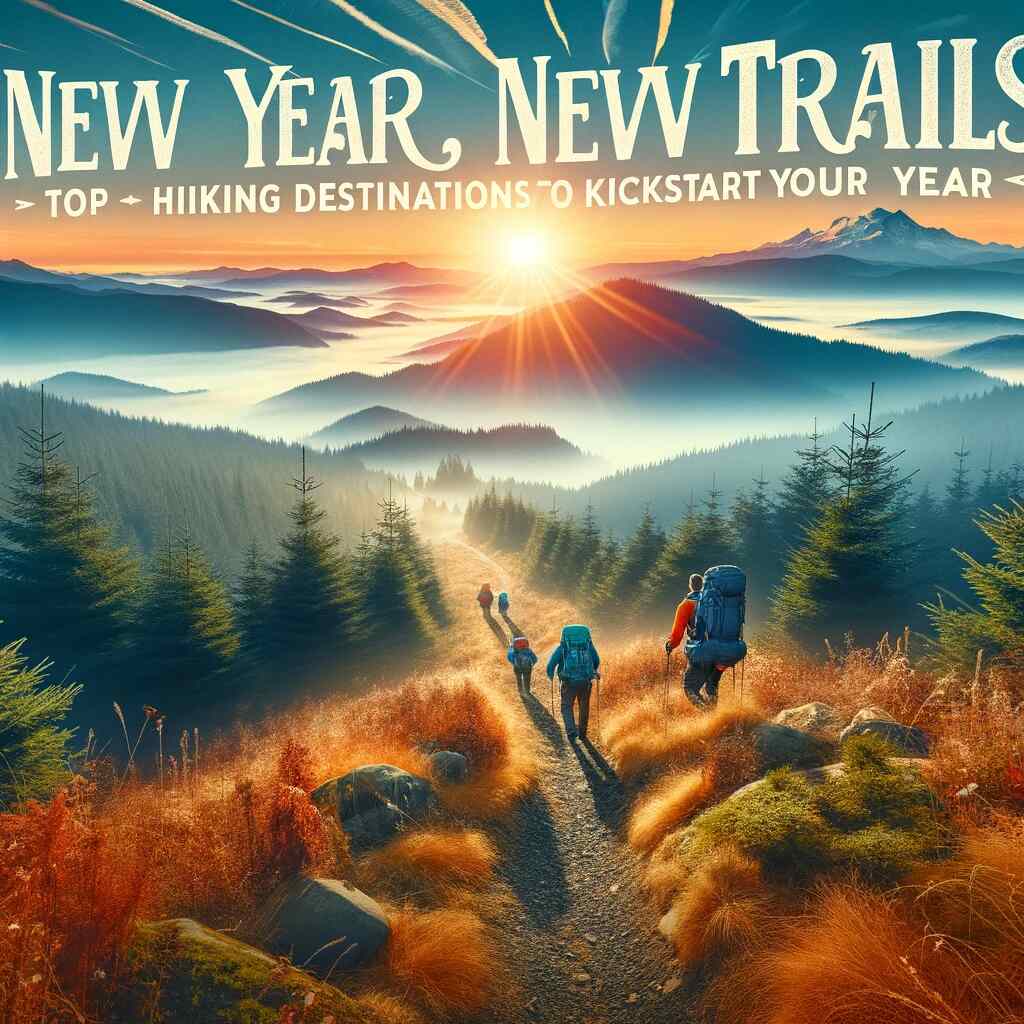Are you ready to kickstart your year with a burst of adventure and a breath of fresh air? The dawn of a new year is the perfect opportunity to embrace the great outdoors, set new hiking goals, and explore breathtaking trails that will invigorate your spirit. Get ready to discover the trails that will make 2024 a year to remember – because it’s time for New Year, New Trails: Top Hiking Destinations to Kickstart Your Year!
Embracing Winter Hiking: Tips for a Safe and Enjoyable Experience
Before we dive into the top hiking destinations for the New Year, it’s essential to be prepared for winter hiking. Unlike hiking in the warmer months, winter hiking presents its own set of challenges. Here are some valuable tips to ensure a safe and enjoyable winter hiking experience:
1. Dress in Layers:
The key to staying warm during winter hiking is layering your clothing. Start with a moisture-wicking base layer to keep sweat away from your body. Add an insulating layer for warmth and finish with a waterproof and windproof outer layer to protect against the elements. Don’t forget to wear moisture-wicking socks, insulated boots, gloves, and a warm hat.
2. Check the Weather:
Stay updated on the weather forecast for your chosen hiking destination. Winter weather can be unpredictable, so it’s crucial to know what to expect. Be prepared for changes in conditions and have a backup plan in case the weather takes a turn for the worse.
3. Carry Essential Gear:
Pack essential gear for winter hiking, including:
- Navigation tools: Maps, compass, and a GPS device.
- Headlamp or flashlight: Days are shorter in winter, and you might end up hiking in low light conditions.
- First aid kit: Include items like adhesive bandages, pain relievers, and blister treatment.
- Emergency shelter: A compact bivy sack or space blanket can provide warmth in case you get stranded.
- Food and water: High-energy snacks and a thermos with a warm beverage can keep you fueled and hydrated.
- Fire-starting tools: Matches, a lighter, and firestarter can be lifesaving in an emergency.
4. Be Cautious with Icy Terrain:
Icy trails can be treacherous. Consider bringing traction devices like microspikes or crampons to prevent slips and falls. Also, use trekking poles for added stability.
5. Start Early:
Days are shorter in the winter, so plan to start your hike early to maximize daylight hours. This allows you to complete your hike before it gets dark, reducing the risk of getting lost or caught in the cold after sunset.
6. Let Someone Know Your Plans:
Always inform someone of your hiking plans, including your expected return time. In case of an emergency, this information can be crucial for search and rescue efforts.
Now that we’ve covered the essential winter hiking tips, let’s explore some of the top hiking destinations where you can kickstart your New Year’s adventure.
1. Yellowstone National Park, Wyoming
Yellowstone National Park is a winter wonderland that offers a unique and serene hiking experience. Known for its geothermal features, diverse wildlife, and pristine landscapes, Yellowstone in the winter is a true natural spectacle.
Hiking Trails in Yellowstone:
- Lone Star Geyser Trail: This moderate 4.8-mile round-trip trail takes you to the Lone Star Geyser, a spectacular sight when surrounded by snow. The geyser erupts approximately every three hours, shooting hot water and steam into the crisp winter air.
- Fairy Falls Trail: A 5.4-mile round-trip hike through snow-covered forests leads to the mesmerizing Fairy Falls. In the winter, the falls freeze into a stunning ice sculpture, creating a magical atmosphere.
- Biscuit Basin Trail: Explore the Biscuit Basin area on this easy 2.8-mile loop trail. You’ll encounter colorful hot springs and geysers, some of which remain active even in the coldest months.
Winter Hiking Tips for Yellowstone:
- Check the park’s website for trail conditions and closures.
- Be cautious around geothermal features, as they can be hidden under snow and ice.
- Carry bear spray, as bears may still be active in the winter months.
2. Acadia National Park, Maine
Acadia National Park is a jewel of the northeastern United States, known for its rugged coastline, granite peaks, and diverse ecosystems. In the winter, Acadia transforms into a peaceful and secluded paradise for hikers.
Hiking Trails in Acadia:
- Jordan Pond Path: This easy 3.3-mile loop trail offers picturesque views of Jordan Pond and the surrounding mountains. In winter, the pond often freezes, creating a stunning icy landscape.
- Cadillac Mountain South Ridge Trail: For a more challenging hike, tackle the South Ridge Trail to the summit of Cadillac Mountain, the highest peak on the Atlantic coast. The 7.2-mile round-trip trail rewards hikers with breathtaking panoramic views.
- Bubble Rock Trail: This 1.4-mile out-and-back trail leads to the iconic Bubble Rock, a massive glacial erratic precariously perched on the edge of a cliff. The trail provides stunning vistas of Jordan Pond and the surrounding mountains.
Winter Hiking Tips for Acadia:
- Be aware of changing weather conditions and icy trails. Microspikes or crampons are highly recommended.
- Check the park’s website for updates on trail closures and road access.
3. Yosemite National Park, California
Yosemite National Park is a renowned destination for outdoor enthusiasts, and its winter beauty is equally captivating. The iconic granite cliffs, frozen waterfalls, and quiet solitude make Yosemite a perfect choice for a New Year’s hiking adventure.
Hiking Trails in Yosemite:
- Upper Yosemite Falls Trail: This challenging 7.6-mile round-trip hike takes you to the top of Yosemite Falls, one of the tallest waterfalls in North America. In winter, the falls may be partially frozen, creating a stunning ice formation.
- Mirror Lake Trail: A relatively easy 2.4-mile round-trip hike leads to the tranquil Mirror Lake, where you can enjoy breathtaking reflections of Half Dome and surrounding cliffs. The lake often freezes in the winter, adding to its charm.
- Mariposa Grove of Giant Sequoias: Explore the giant sequoia trees in Mariposa Grove on a 2.2-mile loop trail. These ancient trees are awe-inspiring year-round, but the snow-covered landscape adds a touch of magic in the winter.
Winter Hiking Tips for Yosemite:
- Check for trail closures and weather conditions on the Yosemite National Park website.
- Carry tire chains for your vehicle if you plan to drive into the park, as roads can be icy.
4. Rocky Mountain National Park, Colorado
Rocky Mountain National Park is a haven for winter hikers and outdoor enthusiasts. With its rugged terrain, snow-covered peaks, and abundant wildlife, it offers a serene and picturesque winter wonderland.
Hiking Trails in Rocky Mountain National Park:
- Emerald Lake Trail: This 3.6-mile round-trip trail takes you through a winter wonderland of pine forests and frozen lakes. Emerald Lake, surrounded by towering peaks, is especially stunning in the winter.
- Bear Lake Loop: An easy 0.8-mile loop around Bear Lake offers stunning views of Hallett Peak and the surrounding mountains. The lake freezes in the winter, creating a serene and reflective surface.
- Dream Lake Trail: For a slightly longer hike, take the 2.2-mile round-trip trail to Dream Lake. The trail passes through stunning alpine scenery and leads to a beautiful frozen lake nestled beneath Hallett Peak.
Winter Hiking Tips for Rocky Mountain National Park:
- Check the park’s website for trail conditions, closures, and avalanche danger.
- Be prepared for cold temperatures and rapidly changing weather.
5. Great Smoky Mountains National Park, Tennessee/North Carolina
The Great Smoky Mountains National Park, straddling the border between Tennessee and North Carolina, is known for its misty valleys, old-growth forests, and diverse wildlife. In the winter, the park takes on a serene and mystical atmosphere.
Hiking Trails in Great Smoky Mountains National Park:
- Alum Cave Trail: This 4.4-mile round-trip trail takes you to Alum Cave Bluffs, a massive concave rock formation. In winter, the bluffs can be adorned with icicles, creating a magical sight.
- Clingmans Dome: Hike the 1-mile round-trip trail to the Clingmans Dome Observation Tower, the highest point in the park. In winter, the tower often offers stunning views of snow-covered peaks.
- Laurel Falls Trail: An easy 2.6-mile round-trip trail leads to the picturesque Laurel Falls, the highest waterfall accessible by a paved trail in the park. In the winter, the falls may freeze partially, creating a captivating scene.
Winter Hiking Tips for Great Smoky Mountains National Park:
- Be aware of icy conditions on the trails and consider bringing traction devices.
- Check for road closures and weather updates on the park’s website.
Finding Local Trails for Your New Year’s Adventure
Not everyone can travel to these national parks for a New Year’s hiking adventure. Fortunately, there are often fantastic hiking opportunities right in your local area. Here are some tips for finding and exploring local trails:
1. Use Hiking Apps and Websites:
Several apps and websites can help you discover nearby hiking trails. Popular options include AllTrails, Hiking Project, and TrailLink. These platforms provide detailed trail maps, user reviews, and photos to help you choose the best hike for your skill level and preferences.
2. Join Hiking Groups:
Joining local hiking clubs or groups on social media platforms like Facebook can be a great way to connect with fellow hikers and learn about hidden gems in your area. These groups often organize group hikes and share valuable trail information.
3. Consult Local Outdoor Retailers:
Visit local outdoor retailers, such as REI or specialty hiking stores, where you can find maps, guidebooks, and advice from experienced staff. They may also host workshops and events related to hiking and outdoor activities.
4. Explore State and County Parks:
State and county parks can be excellent sources of local hiking opportunities. These parks often offer well-maintained trails, visitor centers with information, and a range of landscapes to explore.
5. Consider Seasonal Changes:
Don’t limit your hiking adventures to just one season. Exploring the same trail in different seasons can provide a completely different experience. Spring and fall can offer vibrant foliage, while winter hikes can provide a serene and snow-covered landscape.
Final Thoughts
Embarking on a hiking adventure to kickstart your New Year is an excellent way to connect with nature, stay active, and rejuvenate your spirit. Whether you choose to explore the winter wonders of national parks like Yellowstone, Acadia, Yosemite, Rocky Mountain, or Great Smoky Mountains, or opt for local trails in your area, the beauty of the outdoors awaits.
Remember to prepare for winter hiking with appropriate clothing, gear, and safety measures. Always check trail conditions and weather forecasts before heading out, and inform someone of your plans. With the right preparation and a sense of adventure, you can make the most of the new year and create lasting memories on the trails.










